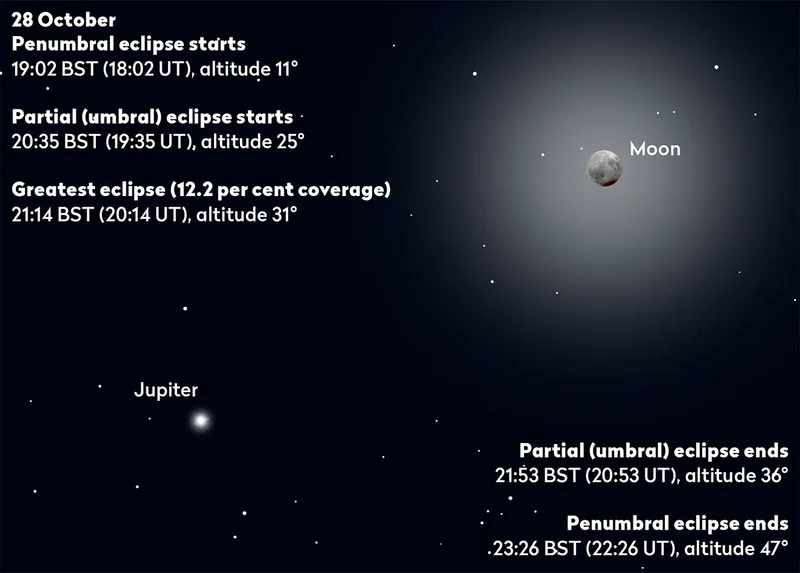Are you planning on taking advantage of the darkening autumnal nights and the partial lunar eclipse this weekend?
You can also watch the Moon dance with Jupiter in the late evening sky, accompanied by the Pleiades open star cluster, Aldebaran (the red 'eye' of Taurus the Bull) and Betelgeuse in Orion.
The 28 October partial lunar eclipse will be quite a tricky event to see for beginners, as only a small southern portion of the Moon will be darkened by Earth's shadow.
For more on this, read our guide to the 28 October partial lunar eclipse key timings.
Enjoy the darker nights with our guides to the best autumn constellations and the best autumn stargazing targets

However, autumn is a great night to get looking up at the night sky, and there will be a few well-known favourites accompanying the Moon on Friday, Saturday and Sunday night, 27 - 29 October
Not least Jupiter, which reaches opposition on 2 November 2023.
Opposition is when a planet is positioned on the opposite side of Earth from the Sun, and is a brilliant time to observe that planet.
Below is our guide to what the Moon and Jupiter are doing this weekend, and what you can see in the night sky along with them.
Our images show the sky at 22:30 BST (UTC+1), apart from Sunday when Daylight Savings will have ended, and the time will be 22:30 UTC.
But if you use a stargazing and astronomy app, you can check what's in the night sky earlier in the evening, should you wish to get younger children involved.
Our charts were produced using the Stellarium app, which is a fantastic resource. Find out more in our guide on how to install and use Stellarium.
Jupiter and Moon events this weekend
27 October 2023

On 27 October at 22:30 BST, the Moon will be visible in the southeast.
Look to the left of it and you'll be able to see the planet Jupiter with the naked eye.
Look to the left again and slightly below and see if you can spot Aldebaran, which is a prominent star of autumn and winter, forming the fiery eye of Taurus the Bull.
You may also be able to spot the Pleiades, a bluish open star cluster that's visible with the naked eye and which looks spectacular through even a modest pair of binoculars.
The bright Moon will make other targets quite tricky to see, but Jupiter will be prominent enough to withstand the lunar glare.
Avoid light pollution and let your eyes dark-adapt for about 20 minutes to see if you can spot Aldebaran and the Pleiades.
28 October 2023

On the evening of the partial lunar eclipse, Jupiter will be much closer to the Moon than it was the night before.
The Moon and Jupiter again form a line with Aldebaran, and the Pleiades appears roughly in the same position too, relative to the other bodies.
If you are out observing the lunar eclipse, take time to spot the star, cluster and the gas giant in the sky.
29 October 2023

We close out the weekend with the Pleiades, the Moon and Jupiter in a neat line together, Aldebaran hanging below the trio.
Our chart still shows the view at 22:30, but because the UK clocks have changed back to GMT, we've gained an hour.
This means the constellation Orion is now higher in the sky, providing a glimpse of what we can look forward to as the hunter climbs higher during the winter months.
See if you can spot red star Betelgeuse, which is a giant star that forms the shoulder of Orion.

